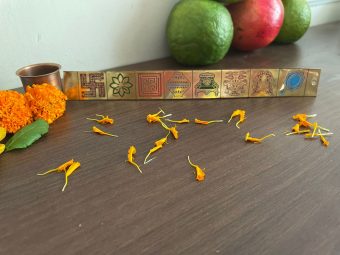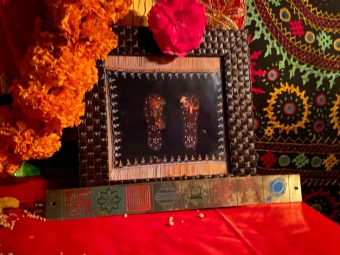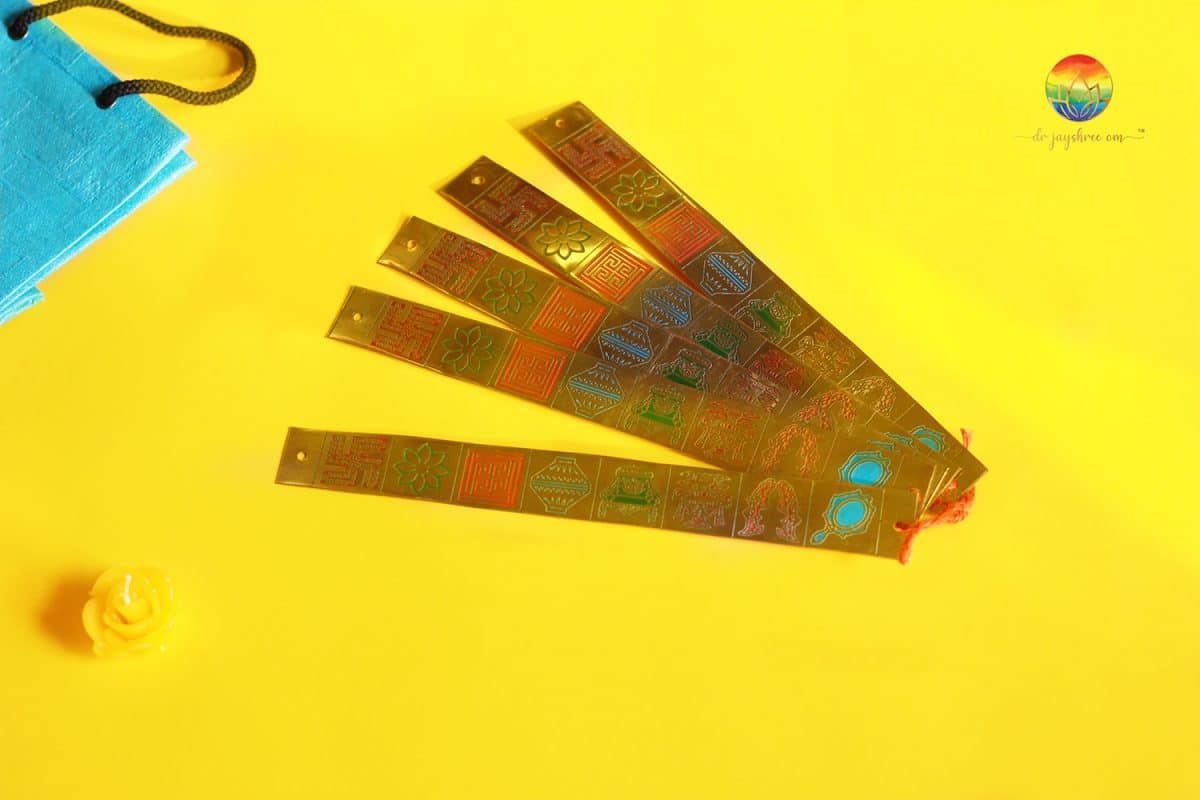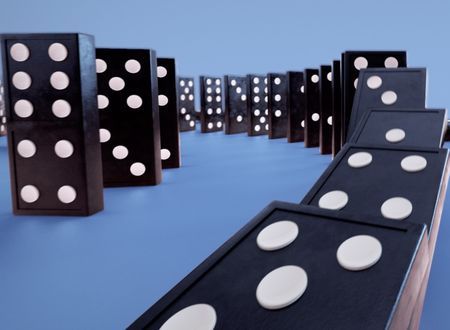An incredible auspicious yantra since time immemorial.

Asthamangala is a specially designed and energized brass plate with embossed insignia of 8 holy symbols. The mention of this Yantra or Amulet is found in many Vedic texts. A mention can be found in our Vastu scripture of Sanatana dharma, namely Mayamat by Rishi Maya Muni, Chapter 12-Garbhavinyas, Verses 34-36. He has asked to place this symbol plate under the threshold. In ancient times, this was carved on gold for the kings and used as an important ingredient for the Garbhvinyas vidhi. Garbha means- womb and vinyas means procedure. Garbhavinyas means energizing of the land, which is done by placing auspicious items below the floor.
The Ancient Shastra describes Asthamangala as …
~A highly auspicious yantra which brings immense success, wealth, and happiness to the user.
~Astha means eight and Mangala means auspicious. This yantra is mentioned in all major subcontinental religions, like Hinduism, Jainism, and Buddhism.
~Eight (8) is considered an important number in the context of classical Indian literature.
~In Vastu 8 directions are considered which are north, south, east, west NE (Ishanya), SE (Agni), SW (Nairitya) & NW (Vayvyaya).
~All Ayadi Calculations are also performed with significant usage of number 8.
The holy symbols inscribed on Asthamangala are:
- Swastika (four-armed cross): Universal Symbol of Prosperity.
- Srivatsa (rhomboid mark): Endless Knot is the embodiment of eternal love. It also denotes twin characteristics of love and compassion.
- Nandyavrat (nine-pointed diagram): nine corners, denotes the abundance of nine types of material, physical, spiritual, and mental wealth and treasure.
- Vardhmana (food vessel): Signifies a steady supply of food. Also, shows an increase in wealth, fame, and riches.
- Bhadrasana (throne): Auspicious by virtue of being blessed by the feet of the Lord.
- Purana-Kalasha (pot): Facilitates entry of joy, happiness, and grace in a home. This is mentioned in Vastu scriptures many times.
- Mina-Yugala (pair of fish): Representation of fertility, abundance. Also represents two holy rivers of India, the Ganga & Yamuna.
- Darpan (mirror): Symbolises clarity and purity of thoughts.
Many scriptures mention placing auspicious symbols on beds, altars, and flags. One such verse is from a Vastu scripture. Mere placing symbols does not help much. We have to know the meaning of and greatness of these symbols for better results. By knowing about them, we are conditioning our minds and mind to understand things better logic is given. We just don’t jump into doing a mantra chanting. Instead, there is a complete set of purushcharana which helps us in preparing ourselves for the main mantra. similarly, we just don’t get married. We look for someone with the same wavelength, understand each other during courtship, and then finally get married on an auspicious day. The same goes with these yantras. We have to establish a connection with them. Pray to them for our well-being and then on an auspicious day we place them where ever we want with a certain desired outcome. This is like watering a plant, the better you take care, the better it grows. Once a plant grows, it gives us fruit and shade. The same goes with a yantra. Be nice, loving, and caring towards your yantra.
Signs and Symbols
श्रीवृक्षवर्द्धमानैश्च ध्वजं छत्रं च चामरम् ।
छेदे दृष्टे तु ह्यारोग्यं विजयं धनवृद्धिदम् ॥ ७२ ॥
Make Sri Vriksha and Vardhaman on a flag,
Umbrella and decorative items.
If these are embossed with such symbols,
Then there is a rise in health, victory, and wealth. ॥ 72 ॥
-Vishwakarma Prakash, chapter 10, verse 72
Usages :
- Water and weatherproof so we can use it inside a decorative water-body.
- Can be framed in a wooden/glass frame.
- Can be nailed directly to the door frame.
- Can be placed below the threshold during construction.
- Can be placed on the study table for better concentration.
- Can be placed on the office table for growth at work.
- Can be placed inside a money locker for abundance.
- Can be nailed to the altar.
One yantra multiple usages.
Dimension:
Length: 9 inches
Width: 1 inch
Designed according to Aaydi sutra (formula) from Viswa Karma Prakash, an ancient Vedic Vastu text.
Mail me for your consecrated piece at jayshreeborad@gmail.com
Photography: Surekha Chandrashekahar. You can mail her at chadrasekharsurekha@gmail.com. She is a member of os.me and an author of the book “The Tastes of Classic Coconut Cuisine”
Editor: Laxmi Duggirala. She is a member at os.me and my soul sister.
More on this yantra on this youtube link
In order from left :
Swastika, Srivatsa, Nandyavrat, Vardhaman, Bhadrasana, Purana-kalash, Mina-Yugala, Darpan












Comments & Discussion
12 COMMENTS
Please login to read members' comments and participate in the discussion.